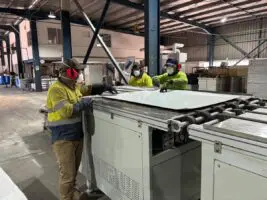 It’s hard to imagine the rhetoric soaring to greater heights.
It’s hard to imagine the rhetoric soaring to greater heights.
“A great signal for Paris”,”a much needed shot in the arm for climate action”, “provide an example of successful international cooperation”, “provide critical momentum for the climate negotiations”, “a strong signal to the UNFCCC to adopt a robust agreement at COP 21”, “boosting global cooperation ahead of Paris to benefit the planet”…
Expectations were almost palpable.
“A singular opportunity for countries to take action on climate”,”would set the stage for an ambitious and durable global climate agreement”, “lay the foundation for a global agreement in Paris that will protect generations to come”, “demonstrate that governments around the world have the political will to take bold action to avert a climate catastrophe”, “potentially catalyse far-reaching action at Paris”…
Stirring stuff indeed, but who’d have guessed what all the fuss was about?
You’d be forgiven for missing the muted clamour anticipating a long overdue agreement on the need to respond to the science calling for international action on the world’s most powerful and rapidly growing greenhouse gases.
In a much anticipated gathering of the global community of nations in Dubai over the past week, intense negotiations have been taking place. The ultimate goal of the talks, which began in 2008, is to amend the Montreal Protocol to formally address the need to address the alarmingly rapid rise of the hydrofluorocarbons, or HFCs, highly potent greenhouse gases used across the refrigeration and air conditioning industries.
A recent NASA study reported to the meeting also confirmed that contrary to previous understanding HFCs do have a small yet significant effect on ozone depletion, a point poignantly underscored by the appearance of the third largest Ozone hole this year.
The numbers are by any measure impressive. At stake is the opportunity to preserve the 135 billion tonnes CO2-e inadvertent climate benefits of phasing out the ozone depleting (and incredibly powerful greenhouse gases) CFCs, to slow the 10-15% annual increases in HFC emissions, to reduce emissions by 100-200 billion tonnes CO2-e by 2050, and to limit the increase in global temperature by 0.5 degrees C by 2100. Failure to act on HFCs would see them contributing up to 29% of global CO2 emissions by 2050.
Progress at the unprecedentedly resumed 36th Open Ended Working Group (from stalemated #OEWG36 meetings in Paris in July) in Dubai prior to the MOP gave rise to initial hopes that prospects of reaching agreement on some combination of the four HFC amendment proposals on the table might be reached.
Formation of a formal “contact group” to consider the proposals and resolve the many challenges and solutions, timing, flexibility, feasibility and financing issues has been a major stumbling block, previously surmounted by “informal discussions”. Establishment of this contact group in order to progress the discussions was a priority objective of Parties supporting the HFC amendment proposals, and removes a critical procedural blockage. Along with China, Australia was privileged to serve as a Co-Chair of this long awaited group.
Delivering a moral imperative to the UNFCCC in Paris to follow the example set in Dubai was tantalisingly within reach. However formidable obstacles and tight timeframes for negotiations to take place conspired against progress being made, in spite of the presence of many senior figures. Pessimistic rumblings that any agreement would be able to be reached were heard during the week, and it was always inevitable that a decision would only be reached long after the scheduled closing time.
Whilst the genuine virtues of the Montreal Protocol as the world’s most successful Multilateral Environmental Agreement are frequently and legitimately proclaimed at these meetings, the deeply regrettable deafness of the Parties in the 1990’s to concerns raised by Greenpeace (among others) about the climate impacts of HFCs is rarely acknowledged.
In the rush to phase out CFCs while limiting the financial impacts on the balance sheets of chemical companies, it is unfortunate that the solutions then presented by climate friendly natural refrigerants were overlooked.
Wiser allocation of the resources of the Montreal Protocol twenty years ago to support research and commercialisation of ammonia, carbon dioxide, hydrocarbons, air and water (the “friendly five”) could have averted much of the HFC (and HCFC) problem we currently face.
Fortunately these future proof, climate safe solutions are now available, and the pace of innovation and scale of commercialisation are impressive. However gaining acceptance of these realities among the parties who continue to obstruct agreement on the HFC amendment appears to be a long way off.
By adopting a significantly more ambitious goal to comprehensively act on phasing out HFCs in Australia, there is much our newly innovative and agile Government could be doing to take responsibility for reducing our HFC emissions, setting an example to the world, and fostering the ability of Australian industry to meet the enormous global demand for climate friendly cooling technologies.
Much talk in the Dubai meeting Plenary and HFCs Management Contact Group has focussed on strategies to keep the amendment proposals alive, and to establish a “Dubai Roadmap” to achieve real progress in 2016. While a substantial majority of the 197 countries present are supportive of adopting an amendment, a small yet persistent group led by Saudi Arabia have continued to obstruct negotiations.
Ostensibly their opposition is due mainly to concerns about the availability of climate friendly solutions suited to high ambient temperatures, yet the strategy of holding out in exchange for concessions at the Paris talks is only thinly disguised.
Perhaps the Dubai MOP is best summed up by a delegate reported as remarking in the corridors “If the camel once gets his nose in the tent, the body will soon follow”.
It took until the wee small hours of Friday morning for the Contact Group to deliver an agreed text to the Plenary that sets a clear path for decisive progress, and sets up an extraordinary meeting to achieve this next year.
What is important is the process has moved a large step forward, and the inexorable momentum to secure an amendment in 2016 to begin to stem the flow of HFCs remains strong.
In common with efforts at the UNFCCC talks, what the efforts under the Montreal Protocol to save the climate share is that they are not moving fast enough. Nevertheless, the progress made this week in Dubai serves to illustrate that in spite of widely divergent interests and circumstances, the international community is able to come together to face common challenges.
At the very least, the camel’s nose is finally now firmly inside the tent, and in line with the proverb there is every likelihood the body will not remain outside for much longer.
Brent Hoare is an environmental campaigner who has been interested in the HFC debate since the late 1990’s.







